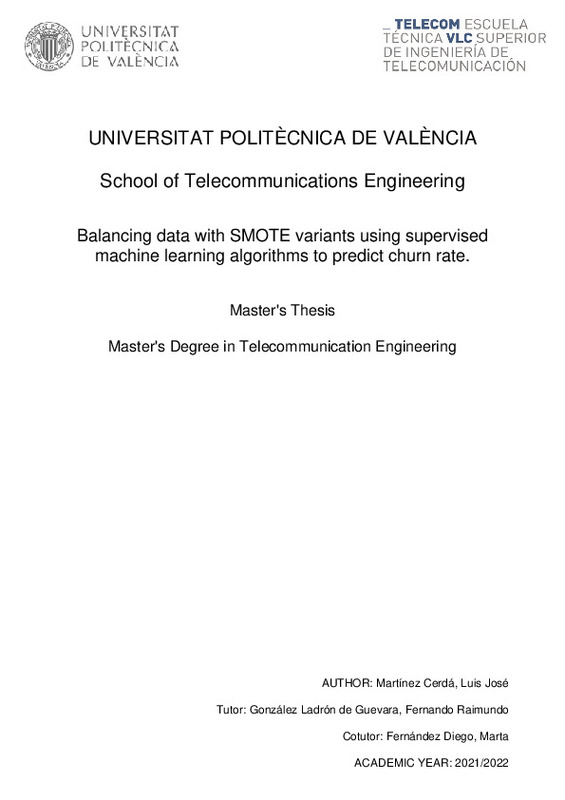JavaScript is disabled for your browser. Some features of this site may not work without it.
Buscar en RiuNet
Listar
Mi cuenta
Estadísticas
Ayuda RiuNet
Admin. UPV
Balancing data with SMOTE variants using supervised machine learning algorithms to predict churn rate.
Mostrar el registro sencillo del ítem
Ficheros en el ítem
| dc.contributor.advisor | González Ladrón de Guevara, Fernando Raimundo
|
es_ES |
| dc.contributor.advisor | Fernández Diego, Marta
|
es_ES |
| dc.contributor.author | Martínez Cerdá, Luis José
|
es_ES |
| dc.date.accessioned | 2022-10-15T07:11:25Z | |
| dc.date.available | 2022-10-15T07:11:25Z | |
| dc.date.created | 2022-09-26 | es_ES |
| dc.date.issued | 2022-10-15 | es_ES |
| dc.identifier.uri | http://hdl.handle.net/10251/187903 | |
| dc.description.abstract | [ES] Balancing problem New alternatives to obtain balanced data has been used in the recent times of machine learning applications. Oversampling and undersampling in data analysis are techniques used to adjust the class distribution of a source data. Presenting our data The dataset used in this project contains the churn rate of an e-commerce site, being this the of clients that would potentially cancel their membership. The situation is that a small amount of the samples contains the clients that are exited, thus, we are presented with an imbalanced dataset. SMOTE Stage In this project Multiple variants of SMOTE (Synthetic Minority Over-sampling Technique) are presented in a competition to find the model that find the best solution for this problem. We will select the algorithms for this task relying on the Smote Variants package that could be found in Python. Prediction Stage By means of a competition of widely used supervised algorithms we will obtain the optimal model to predict this churn rate. | es_ES |
| dc.description.abstract | [EN] Balancing problem New alternatives to obtain balanced data has been used in the recent times of machine learning applications. Oversampling and undersampling in data analysis are techniques used to adjust the class distribution of a source data. Presenting our data The dataset used in this project contains the churn rate of an e-commerce site, being this the of clients that would potentially cancel their membership. The situation is that a small amount of the samples contains the clients that are exited, thus, we are presented with an imbalanced dataset. SMOTE Stage In this project Multiple variants of SMOTE (Synthetic Minority Over-sampling Technique) are presented in a competition to find the model that find the best solution for this problem. We will select the algorithms for this task relying on the Smote Variants package that could be found in Python. Prediction Stage By means of a competition of widely used supervised algorithms we will obtain the optimal model to predict this churn rate. | en_EN |
| dc.format.extent | 46 | es_ES |
| dc.language | Español | es_ES |
| dc.publisher | Universitat Politècnica de València | es_ES |
| dc.rights | Reserva de todos los derechos | es_ES |
| dc.subject | Churn rate | es_ES |
| dc.subject | SMOTE | es_ES |
| dc.subject | Balancing data | es_ES |
| dc.subject | Oversampling | es_ES |
| dc.subject | Machine learning | es_ES |
| dc.subject.classification | ORGANIZACION DE EMPRESAS | es_ES |
| dc.subject.other | Máster Universitario en Ingeniería de Telecomunicación-Màster Universitari en Enginyeria de Telecomunicació | es_ES |
| dc.title | Balancing data with SMOTE variants using supervised machine learning algorithms to predict churn rate. | es_ES |
| dc.title.alternative | Balancing data with SMOTE variants using supervised machine learning algorithms to predict churn rate. | es_ES |
| dc.title.alternative | Equilibrar les dades amb variants SMOTE mitjançant algorismes d'aprenentatge automàtic supervisat per predir la taxa de rotació. | es_ES |
| dc.type | Tesis de máster | es_ES |
| dc.rights.accessRights | Abierto | es_ES |
| dc.contributor.affiliation | Universitat Politècnica de València. Departamento de Organización de Empresas - Departament d'Organització d'Empreses | es_ES |
| dc.contributor.affiliation | Universitat Politècnica de València. Escuela Técnica Superior de Ingenieros de Telecomunicación - Escola Tècnica Superior d'Enginyers de Telecomunicació | es_ES |
| dc.description.bibliographicCitation | Martínez Cerdá, LJ. (2022). Balancing data with SMOTE variants using supervised machine learning algorithms to predict churn rate. Universitat Politècnica de València. http://hdl.handle.net/10251/187903 | es_ES |
| dc.description.accrualMethod | TFGM | es_ES |
| dc.relation.pasarela | TFGM\151107 | es_ES |
Este ítem aparece en la(s) siguiente(s) colección(ones)
-
ETSIT - Trabajos académicos [2408]
Escuela Técnica Superior de Ingenieros de Telecomunicación






